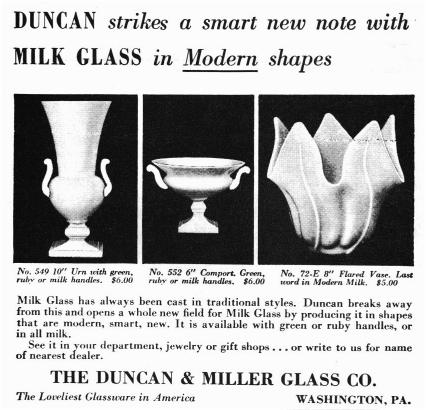National Depression Glass Association
Preserving America's Glass Manufacturing Heritage
Duncan's Milk Glass
by Gail Krause
Glass Review - January 1979
Sugar and Spice and everything nice - that is what the nursery rhyme
says about little girls, but we could almost apply the same to Duncan's
 Milk Glass. (I would like to correct the section on milk glass in
The Encyclopedia of Duncan Glass, those printed pages of glass were
made at the Tiffin plant at Tiffin, Ohio, under the Duncan division and
not at the Duncan plant, as formerly thought.) The items in this
article today were made in Washington, Pa.
Milk Glass. (I would like to correct the section on milk glass in
The Encyclopedia of Duncan Glass, those printed pages of glass were
made at the Tiffin plant at Tiffin, Ohio, under the Duncan division and
not at the Duncan plant, as formerly thought.) The items in this
article today were made in Washington, Pa.
Milk glass is comprised of the following ingredients: Sand, Felspar, Sodium Nitrate, Zinc Oxide, Borax, Alumini, Red Lead, Clay, Soda Ash, Littange and Clay Potash, Cryolite and Fluorspar. These ingredients must be accurately measured and mixed properly, otherwise the glass would be seedy and off color. Many hours of careful planning and skill are necessary to achieve the finished product that came up to Duncan's standards.
When one thinks of Duncan and Miller glass, the reaction is to visualize shimmering clear crystal, soft shades of pink, green, amber and of the more vivid cobalt, ruby and ebony and the later colors of pink, blue and yellow opalescent.
The factory produced these colors along with milk glass in their plant on Jefferson Avenue in Washington, Pennsylvania, very successfully, until the Second World War, when the defense of the Country needed some of the ingredients used in milk glass and the opalescent. The plant discontinued making those colors to help aid their Country. Many of Duncan's collectors are not aware that part of the plant was used for Army and Naval defense. Incidentally, the clay pigeons were made there.
Some of the items made in milk glass were as follows: Baskets:
3-4-5-10 inch with Ruby and Green handles; Murano No. 127 Flower
arranger and 5-9-10 inch crimped bowls also 9-10-12½ inch oval
ones. A 7 inch flared one was also made. This is a very attractive one
with the open lattice work on top. If you have The Encyclopedia of
Duncan Glass it will be shown in crystal on page 47. This pattern
 looks very beautiful when ribbon is laced through the openings. The
flower arranger is pretty much the same except the ruffled edge is
turned in toward the center. The oval pieces were pinched together at
the center of the bowl and open on the ends. The 7 inch candy dish was
shaped more like an underplate and is often used under the vase or
flower arranger.
looks very beautiful when ribbon is laced through the openings. The
flower arranger is pretty much the same except the ruffled edge is
turned in toward the center. The oval pieces were pinched together at
the center of the bowl and open on the ends. The 7 inch candy dish was
shaped more like an underplate and is often used under the vase or
flower arranger.
No. 122 Sylvan -- Some of the items made in the 7½ and 10 inch, 3-compartment relish were made with green and ruby handles. Other items made are two sizes of ashtrays, 3 and 5 inch, along with the cigarette holder, 7 inch flared vase and also a 5½ inch bonbon with colored handles. A 7½ inch mint dish with the same combination was a very popular item. One of the most beautiful pieces producec was the 7 inch flared vase in Sylvan, this has the divided center with the ripples on either side and the points coming straight up and out.
Several sizes of urns were made in milk glass 5½ and 7 inch with the styles as follows: No. 549 Urns with the handles made in a closed circle and square feet, also the one with the handles turned to the top and the urn without handles. Compotes also were made in this combination.
The beautiful No.30 Pall-Mall swans we have seen are in 7, 10½ and 12 inch. We have never had the opportunity of seeing a 3½ inch in milk glass, nor are we sure that Duncan ever made one. It is not listed on the price sheet from the factory as were the other sizes.
We would like to save some of the very choice items for last. The Canterbury blank was used for a low milk glass basket 10-12 inch in size. This was extremely popular and was used also as a centerpiece.
Another outstanding article was the candelabra made in the 1-2-3 light or as a hurricane light featuring either ruby or crystal shades. It is with a feeling of great pride to see these items and know that they have survived these many years. It does verify as always that "Duncan is the Loveliest Glassware in America."
Editor's Note: Illustrations used in Gail's column came from early ads - no date given,sorry.